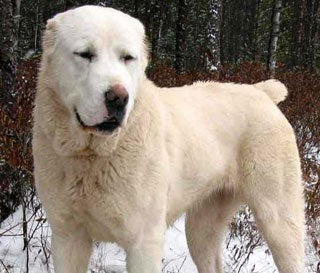Learn about dog breeds
Detailed information & photos on over 190 different breeds
Description
The Central Asian Ovtcharka is a Mastiff type, muscular, strong, large dog with a dominating presence and well-balanced appearance. Many people that have never seen this breed mistake the Ovtcharka for a cross between a Mastiff and St. Bernard.
The Ovtcharka have a long body that is very solid, thick and deep in appearance, with huge, sloping shoulders and hindquarters. They have round, large feet and a body with a straight top line or a slightly arched one depending upon the breed variation. Breeders estimate that there are approximately ten variations of Ovtcharka ranging from Russia to those bred in Afghanistan. Some areas keep the dogs tails a full, natural length while other areas dock the tails short.
The Ovtcharkas intelligent looking, large head resembles that of a mastiff with some of these dogs having prominent wrinkling. There is very little stop from muzzle to forehead and their eyes are alert, deep set, and dark. Many countries are banning the docking of the dogs tail and cropping of the Ovtcharkas ears, which naturally fold over.
The dense coat of this breed comes in either a long or a short length in a large diversity of colors. These large boned dogs with broad, strong backs and big chests have powerful shoulder muscles, thighs, and forelimbs.
Coat Description
Central Asian Ovtcharkas have two different coat varieties. The Russian variety, which is the most common, has a double, longer coat that is dense and thick all year. It has a heavy, thick ruff and a coat that is slightly wavy. The second coat variety more common in other countries such as Afghanistan and is a double coat but less dense and much shorter. Coat colors include Black and tan, straw, grey, red, brindle, black and white, black, or white.
History
The true origin of the four thousand year old Central Asian Ovtcharka is unknown but many people thought that the dog’s ancestor was the Tibetan Mastiff. New genetic evidence proves the Tibetan Mastiff was not an ancestor but close relative. Of the Molosser breed of dogs, the Ovtcharka is believed the oldest in the world. They recognize the Ovtcharka found throughout central Asia by many other names as each nomadic tribe or individual country named this dog breed. Because of this, it was difficult to know which dogs were true breeds and the ones that originated later in various areas and crossed with larger native breeds.
For thousands of years the Central Asian nomadic people used the Ovtcharkas to protect them and their flocks and livestock herds from predators. These dogs were essential to most families and farms and because they were an outdoor dog, this allowed them to evolve into courageous, strong, healthy, self-sufficient animals. Still used as guard dogs and for protection in areas such as Russia, their popularity continues to grow.
Temperament
The Ovtcharkas are calm, independent, dominant, fearless dogs with a powerful protective instinct that will not back down and always stand their ground when necessary. They are very good with their own family members including children, dogs and cats but you must supervise these dogs around children that are strangers. Keep the Ovtcharkas on a leash, as they are often dog aggressive. Their protective nature makes them very suspicious of people they do not know. All Ovtcharkas require extensive training and early socialization.
Health Problems
Although a healthy dog breed, the Ovtcharkas can suffer from some of the large breed disorders such as hip and elbow dysplasia
Grooming
Ovtcharka are light shedders that require very little grooming. They have a double, thick coat that weeds, sticks, and brush do not stick to and mud brushes out of once dried. Brush your dog once a week but daily in spring during the heavy shedding season. Bath the dog only when necessary using a mild dog shampoo. Cut the Ovtcharkas nails monthly or more often if needed using a pair of dog nail clippers and check the dogs ears, eyes, mouth, skin, and feet regularly for any signs of problems or infection.
Exercise
Ovtcharka may appear lumbering, slow, and lazy when they are outside laying down or walking around protecting their property but can be up and running in a fraction of a second. These alert, very agile dogs make great companions for people that love hiking and jogging. They require a moderate amount of exercise such as daily long walks. Ovtcharka love being outside and a large fenced yard allows the dog to monitor, patrol and oversee its territory while staying in good mental and physical shape.
Training
Central Asian Ovtcharkas are moderately independent dogs that prefer living outside but if properly trained, can make an excellent indoor dog. A large, securely fenced yard is essential for the Ovtcharkas, whether they live indoors or out. If confined to a small yard or living conditions, the Ovtcharkas will become bored quickly and start displaying destructive behavior such as chewing and digging. Because they are natural guardian dogs, Ovtcharka may try to dominate people or other dogs. These moderately independent dogs could also cause problems because they are night barkers, so it is extremely important that socialization and training start when these dogs are very young. Properly socialized dogs exposed to many different situations, places, people, sights, and sounds are more confident, less aggressive, and understand what is and is not acceptable behavior. They respond best to loving, firm handling using motivation techniques such as praise, food rewards, and play. Training should always be a positive experience that is creative, fun, and challenging.
Advertise | Privacy Policy | Terms of Use | Contact Us © Copyright 2004-2024 PupCity.com. All rights reserved.
